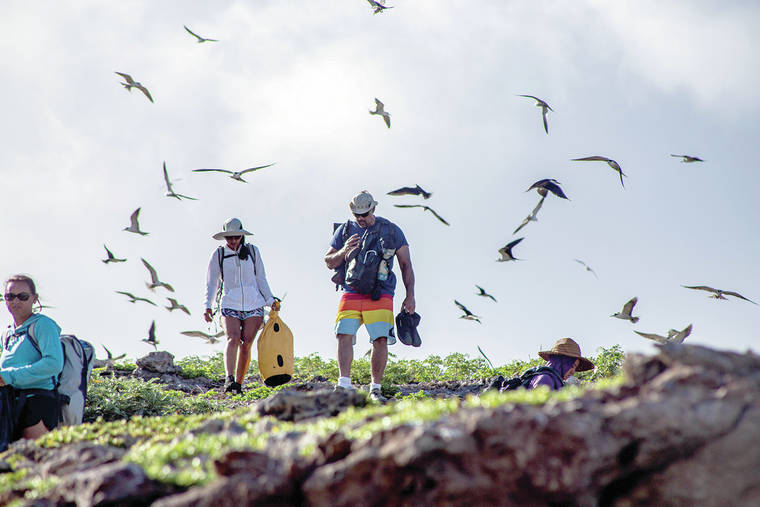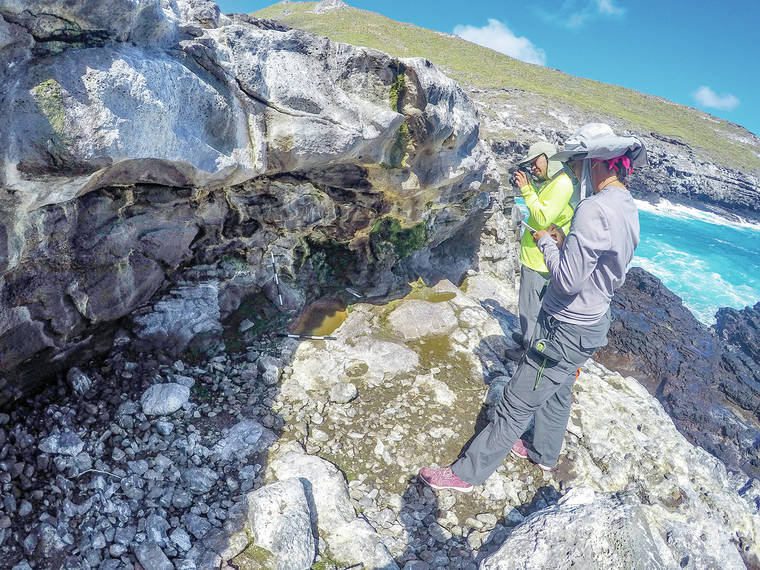HONOLULU — Co-trustees of the Papahanaumokuakea Marine National Monument recently released Mai Ka Po Mai, a historic-guidance document that will help federal and state agencies further integrate Native Hawaiian culture into all areas of management of the 582,578-square-mile protected region in the Northwestern Hawaiian Islands.
“Mai Ka Po Mai is a groundbreaking document,” said Dr. Sylvia Hussey, Office of Hawaiian Affairs CEO and ka pouhana in a press release.
“This document demonstrates that providing Native Hawaiian voices equal footing with federal and state entities in a complex management structure can lead to the successful stewardship of our most precious natural and cultural resources,” she said.
”Moreover, it shows that traditional indigenous resource management is a best-management practice to address climate change and other environmental challenges currently facing humanity. We hope that this stewardship approach is replicated elsewhere in Hawai‘i and throughout the globe.”
Mai Ka Po Mai establishes a collaborative management framework for incorporating Native Hawaiian culture into the stewardship of Papahanaumokuakea for the four monument co-trustees: the federal Department of Commerce and Department of the Interior, state of Hawai‘i and OHA.
OHA is hosting a Mai Ka Po Mai webinar on Tuesday, June 29, at noon. Tune in via Zoom at oha.org/webinar or via the OHA Facebook page for insights on how Hawaiian culture is being integrated into the management of Papahanaumokuakea.
Based on conceptual components of Hawaiian
cosmology and world view, Mai Ka Po Mai articulates values and principles that will guide 20 strategies within five management areas that align with Native Hawaiian culture and values, as well as the various federal and state agency mandates and missions.
Mai Ka Po Mai was developed through continuous and regular meetings with the Native Hawaiian community since 2010. These meetings initially focused on the 2008 Monument Management Plan, which included two action plans relating to Native Hawaiians: the Native Hawaiian Community Involvement Action Plan and the Native Hawaiian Culture and History Action Plan.
Mai Ka Po Mai was created through consultations with the Native Hawaiian community to build on an early action-plan strategy to identify and integrate Native Hawaiian traditional knowledge and management concepts into monument management. Mai Ka Po Mai will serve as the foundation for the update of the MMP, which is currently underway.
“Mai Ka Po Mai was birthed by the Native Hawaiian community and represents our vision for how we should malama this special place,” said Kekuewa Kikiloi, chair of the Native Hawaiian Cultural Working Group. The working group provides advice and recommendations through OHA to the Monument Management Board.
Kikiloi said: “We always believed that the cultural and scientific elements of the monument should not be managed in silos. We thank the co-trustees for committing to a major paradigm shift by supporting Mai Ka Po Mai, which incorporates Native Hawaiian culture and values in every aspect of management.”
Celebrating 15 years since its designation, Papahanaumokuakea Marine National Monument is one of the largest marine-conservation areas in the world.
The monument is cooperatively managed to ensure ecological integrity and achieve strong, long-term protection and perpetuation of Northwestern Hawaiian Island ecosystems, Native Hawaiian culture and heritage resources for current and future generations.
Papahanaumokuakea Marine National Monument was inscribed as the first mixed (natural and cultural) UNESCO World Heritage Site in the U.S. in July 2010.
To read Mai Ka Po Mai, visit oha.org/maikapomai/. For more information on the Papahanaumokuakea Marine National Monument, visit papahanaumokuakea.gov.







Wonderful that this is happening but what about all other lands and ocean. Preservation of the northwestern islands is needed but it cannot stop there. He havai’i au
from here in the south-western Pacific it is just so good that the journey of rekindling and applying your cultural heritage has come to this point. The more custom and traditional knowledge we lose the more difficult it becomes to recover. I look forward to learning of this, as respect that leads to custodianship, can lead to each of us to making change in our place. As we join the dots across our ocean a picture will emerge that others can not help but see.